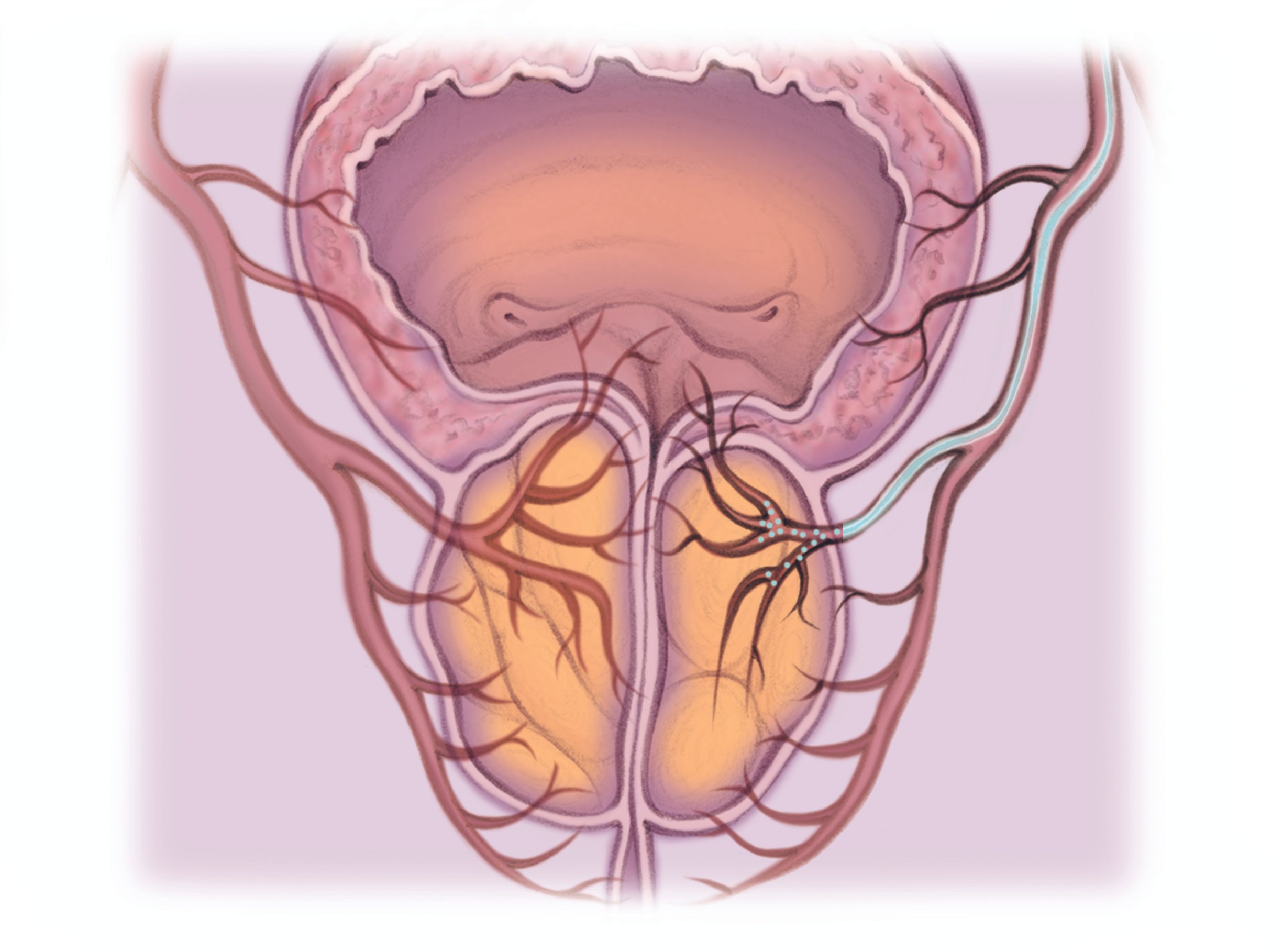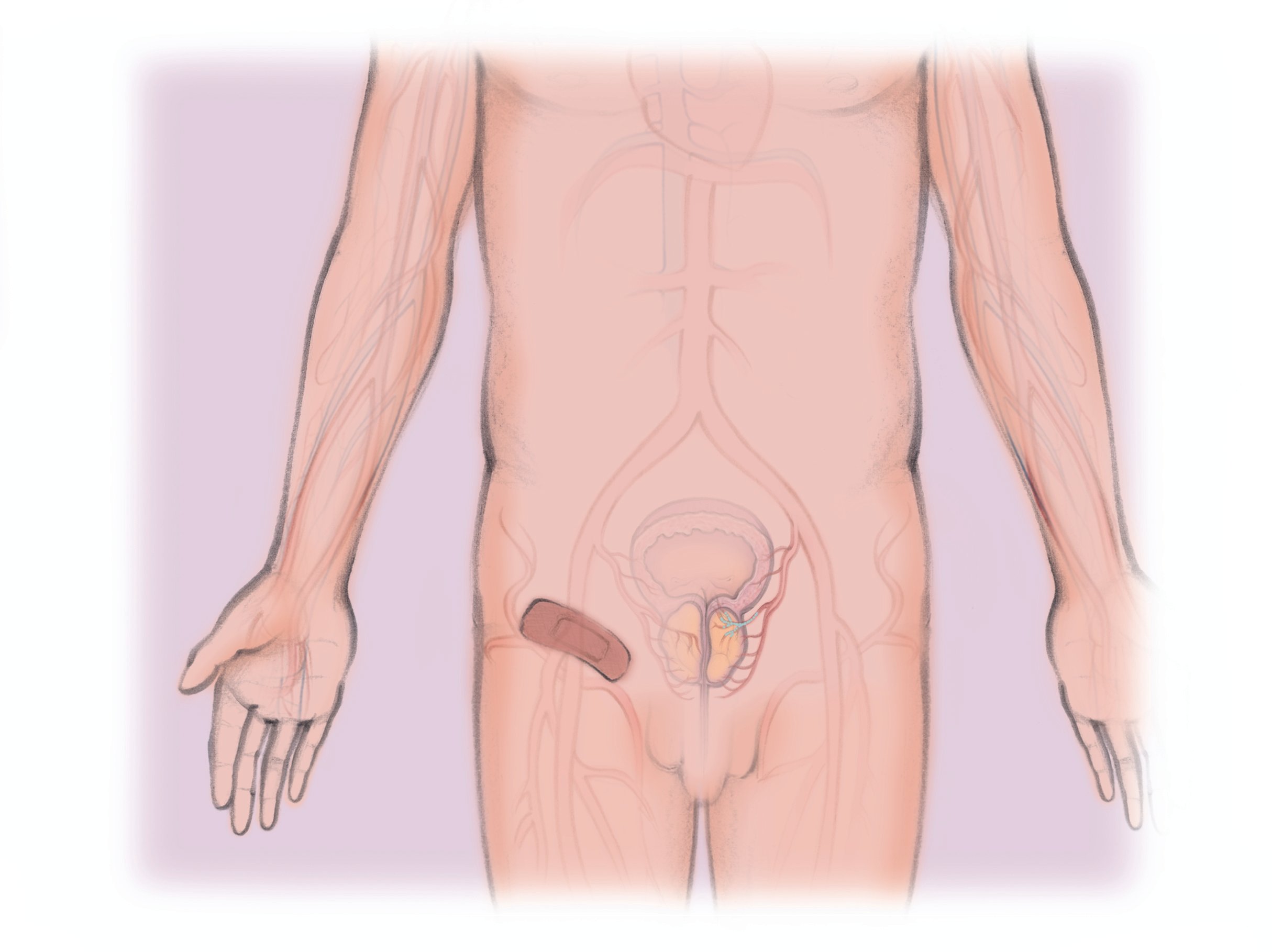Prostate Artery Embolization (PAE)
A minimally invasive treatment for an enlarged prostate
Español
What is Prostate Artery Embolization?
Benign Prostatic Hyperplasia (“BPH”) is when an otherwise normal prostate grows large. It is not cancer. A large prostate makes it hard to pass urine. Because it is hard to empty the bladder, a man with an enlarged prostate has to go to the bathroom more often, including at night.
BPH is very common. It occurs in about half of men 51-60 years old and more than 4 in 5 men over the age of 80.
Prostate Artery Embolization (PAE) is a minimally invasive way of treating BPH by shrinking the prostate.
How is Prostate Artery Embolization done?
PAE is performed by a doctor called an Interventional Radiologist, or IR. The IR inserts a small tube through a blood vessel at the top of the thigh (or wrist). Moving x-rays help the IR guide the tube into the blood vessels feeding the prostate. Next, the IR injects tiny beads through the tube. The beads decrease the prostate’s blood supply, causing it to shrink.
Prostate Artery Embolization
1. After numbing the skin, a small tube is placed into the blood vessel at the top of the thigh or wrist.
2. Using moving x-rays, the clinician will guide the tube to the blood vessel in the prostate and inject special material to block the blood vessel.
3. Once the blood vessel is blocked, the clinician removes the tube and places a bandage over the pinhole in the skin.
What are the risks?
Many people experience discomfort when they urinate and need to urinate more often for a week after the procedure. You may have blood in your urine for a few days after the procedure.
Minor complications occur in 3-7 in 100 people. These include temporary increased difficulty urinating and urinary tract infections.
Major complications occur in less than 5 in 1000 people. These include damage to surrounding structures such as the bladder requiring surgery.
Symptoms return with this procedure more often than surgery. This occurs in is 1 in 5 people. If this occurs, prostate artery embolization may repeated.
What are the alternatives?
Your treatment options depend on your preferences, overall health and unique conditions.
Alternative 1 Supplements such as saw palmetto, beta-sitosterol, cernilton, and Pygeum africanum are less invasive but also less studied and less effective.
Alternative 2 Medications are often tried first and are effective for some people. This treatment also avoids a procedure but may not be effective long-term.
Alternative 3 Surgery to shave away some of the prostate (e.g. TURP) or remove the entire prostate (“prostatectomy”). These treatments tend to be most effect long-term with less risk of symptoms returning. However, they also have the higher risk of complications, occuring in up to 1 in 5 people. Recovery times are also longer than PAE.
Frequently asked questions
What is a prostate?
The prostate is a gland found only in men. The prostate surrounds the neck of the bladder, which holds urine. It is usually the size of a walnut, but the prostate often grows larger later in life. Many older men experience symptoms of an enlarged prostate. This condition is called benign prostatic hyperplasia, or BPH.
What are the symptoms of an enlarged prostate?
An enlarged prostate can make it hard to pass urine, or urinate. This is because an enlarged prostate can partially block the flow of urine out of the bladder. Symptoms of an enlarged prostate are the following:
Needing to urinate frequently
Difficulty urinating, such as having a slow stream or having to strain to urinate
Not being able to control urination, having accidents
These symptoms usually start slowly and gradually get worse over years. In severe cases, an enlarged prostate can make it impossible to urinate normally, which can hurt the kidneys. It is important to talk to your doctor if you think you have problems due to an enlarged prostate.
What is PAE?
PAE is a minimally invasive, image-guided procedure (MIIP) to shrink an enlarged prostate to make it easier to pass urine. It works by using special materials to block some of the blood vessels to the prostate. This causes less blood to flow the prostate so that it shrinks over time. The shrunken prostate does not block the flow of urine as much.
For most patients, the prostate will shrink by approximately 20-40% over the 6 months following PAE.
What can I expect during a PAE?
You will change into a gown and a nurse will put an IV in your arm so you can get medicines.
You will lie flat on your back on a table in the procedure room equipped with moving x-rays.
The nurse may or may not put a small tube through the penis into the bladder.
The nurse will give you medicine through the vein to make you relaxed, comfortable, and drowsy. You will be able to breathe on your own and speak.
The skin of your groin or arm will be cleaned and drapes will be placed over your body.
After numbing the skin, the IR physician will put a thin plastic tube through a pinhole in the skin and into a blood vessel.
The IR then uses moving x-rays to guide the small tube into the blood vessels that supply blood to the prostate.
The IR then injects tiny particles through the tube to block off the blood supply to the prostate.
The IR will remove the tube and will put a small bandage on your skin.
The procedure usually takes 1-4 hours. Your doctor will likely let you go home later on that day or the next day.
What are the benefits of PAE versus the other treatments?
Typically, patients suffering from symptoms due to an enlarged prostate are first treated with medicines. If medicines cannot control the symptoms well enough, other options are surgery or PAE.
Surgery to remove part of the prostate (called a TURP) or all of the prostate (called a prostatectomy) can have side effects, including the following:
Impotence (also called erectile dysfunction, or difficulty maintaining an erection)
Problems with ejaculation
Urinary incontinence (accidents)
PAE is a newer nonsurgical procedure that avoids these side effects. There are clinical trials evaluating this technique in the United States. It is available at select medical centers. Up to 80% of men report improvement of symptoms after PAE. They usually notice improvement starting 1-2 months after the procedure.
For more information about PAE:




